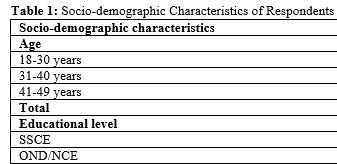Prevalence of Pelvic Inflammatory Disease among Women of Reproductive Age Attending Gynaecology Clinic at Lagos State University Teaching Hospital, Ikeja, Lagos
DOI:
https://doi.org/10.54117/sjmams.v3i1.13Keywords:
Prevalence, Pelvic Inflammatory disease, Women, Reproductive AgeAbstract
Pelvic inflammatory disease (PID) is a polymicrobial infection of the female upper genital tract, mostly caused by Neisseria gonorrhoea and/or Chlamydia trachomatis, while other endogenous flora from the vagino-cervical areas might also be implicated. This study examined the prevalence of PID among women of reproductive age attending Gynaecology Clinic at Lagos State University Teaching Hospital (LASUTH). The study adopted a cross-sectional research design. A total of 218 respondents participated in the study. A 43-item questionnaire was used for data collection, and then analyzed using the statistical package for social sciences (SPSS) version 25 while adopting Chi square for the inferential statistics. Results of the study showed that there was high prevalence of PID 164(75%) among the respondents and 120(55%) had treated the disease previously. The study also revealed that the respondents had poor knowledge about the risk factors and effects of PID; they understood that lower abdominal pain 174(80%) and foul smelling discharge 164(75%) were the major experienced symptoms. Whereas 131(60%) disagreed that multiple sexual partners could cause it. Similarly, 179(82%) were undecided on whether PID could cause complications in pregnancy and 159(73%) strongly disagreed that PID can cause infertility. Also, all respondents 218(100%) agreed that use of pain relief and antibiotics could cause PID. Hypothesis testing revealed that there was no significant relationship between the respondents’ educational level and their knowledge about PID. Conversely, there was a strong association between the occurrence of PID and the women’s age. It was concluded that there is high prevalence of PID among women in Gynecology Clinic at LASUTH (age<25years) who portrayed poor knowledge on the risk factors and effects. It was therefore recommended that the management of LASUTH should invest more time and resources in educating women on the risk factors, preventive measures and complications of PID.

Downloads
Published
How to Cite
Issue
Section
License
Copyright (c) 2024 Rosemond Chidimma Iwu, Dorcas Chika Amie, Oruese Abigail Eduwa, Monsurat Abiodun Sanusi-Borokini, Felicia Adedoyin Augustine, Alice Olukemi Zakari

This work is licensed under a Creative Commons Attribution 4.0 International License.
